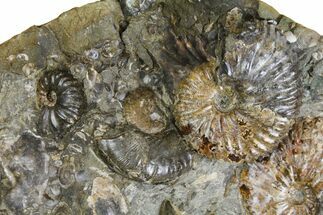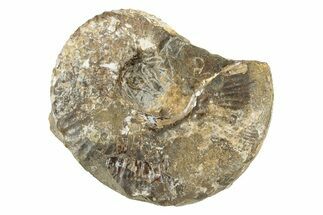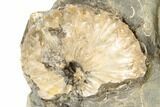This Specimen has been sold.
Fossil Ammonites (Discoscaphites & Jeletzkytes) - South Dakota
This is a 3.2" wide section of rock that contains a Discoscaphites gulosus (1.4" wide) ammonite and a Jeletzkytes sp. (1.3" wide) ammonite, collected from the Fox Hills Formation of South Dakota. Both ammonites exhibit some iridescence, though the Jeletzkytes ammonite has the most color-play of the two. The Jeletzkytes was removed from the rock it was found in, prepared and then remounted to this rock.
It is accompanied by an acrylic display stand to assist with presentation.
It is accompanied by an acrylic display stand to assist with presentation.
These 70 million year old ammonites lived when South Dakota was a shallow inland sea. They were found preserved in concretions when split open. They then had to be hand-prepared to remove the hard rock surrounding them from their shells, a very time consuming task.
About Ammonites
Ammonites were ancient marine cephalopods, similar to today's squids and octopuses, but with a defining feature: their distinctive, tightly coiled spiral shells. These shells, resembling those of modern nautiluses, served as both a protective home and a buoyancy aid, allowing ammonites to navigate the prehistoric seas with ease. First emerging around 240 million years ago in the Triassic Period, ammonites thrived for over 175 million years, adapting through numerous forms and sizes. As predatory creatures, they likely fed on smaller marine organisms, using their tentacles to capture prey. However, their long reign came to an end 65 million years ago at the close of the Cretaceous, coinciding with the mass extinction event that also eliminated the dinosaurs.
Ammonites were ancient marine cephalopods, similar to today's squids and octopuses, but with a defining feature: their distinctive, tightly coiled spiral shells. These shells, resembling those of modern nautiluses, served as both a protective home and a buoyancy aid, allowing ammonites to navigate the prehistoric seas with ease. First emerging around 240 million years ago in the Triassic Period, ammonites thrived for over 175 million years, adapting through numerous forms and sizes. As predatory creatures, they likely fed on smaller marine organisms, using their tentacles to capture prey. However, their long reign came to an end 65 million years ago at the close of the Cretaceous, coinciding with the mass extinction event that also eliminated the dinosaurs.
SPECIES
Discoscaphites gulosus & Jeletzkytes sp.
LOCATION
North Central, South Dakota
FORMATION
Fox Hills Formation
SIZE
Ammonites: 1.4" & 1.3", Rock: 3.2 x 2.1" rock
CATEGORY
SUB CATEGORY
ITEM
#189319
We guarantee the authenticity of all of our specimens.
 Reviews
Reviews














